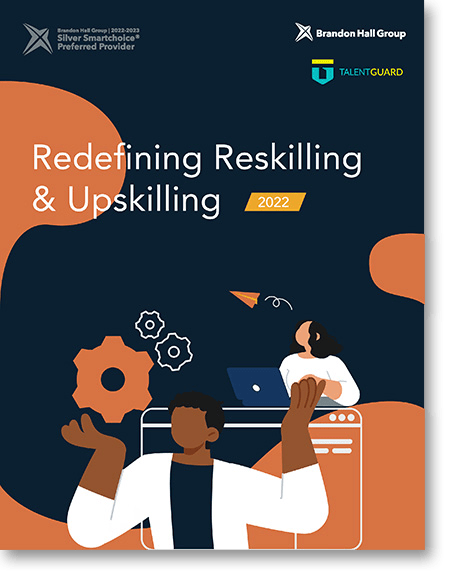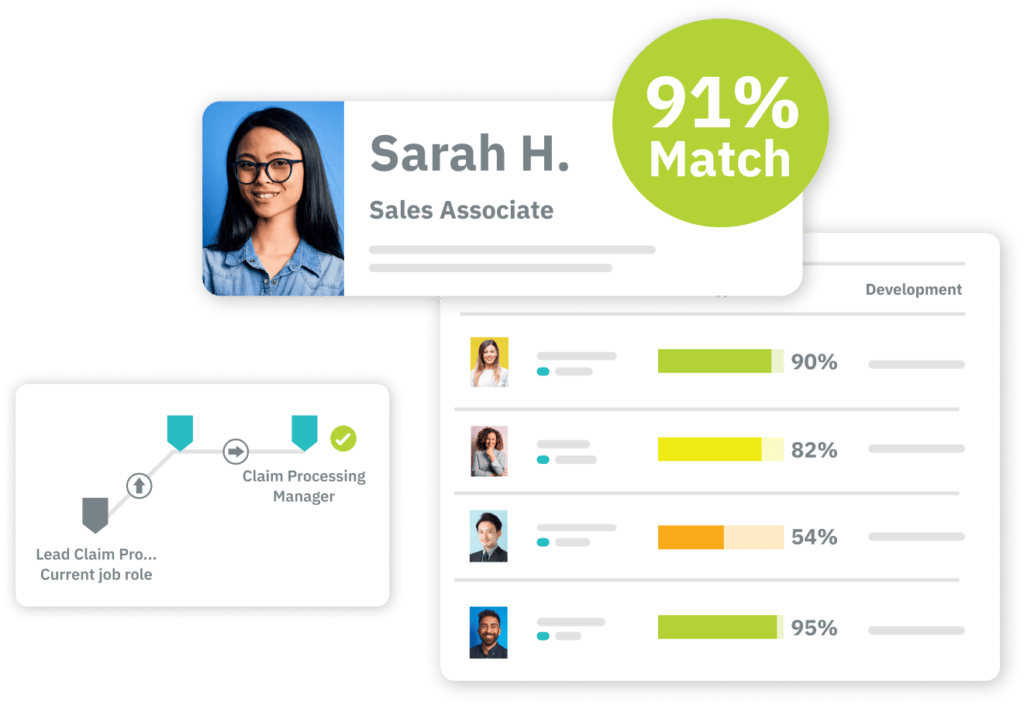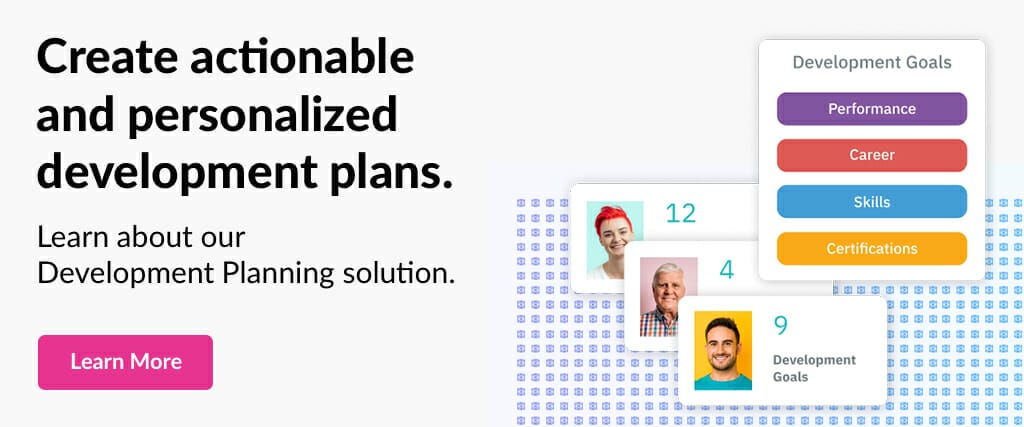Talent Development Strategies
eBook: Redefining Reskilling & Upskilling
New research from Brandon Hall Group dives into everything you need to know to create future-proof talent development strategies through reskilling and upskilling. See examples, better understand the challenges companies may face and more in our eBook, Redefining Reskilling and Upskilling.

Take your company to new heights
Whether your company is grappling with talent management for the first time, looking to modernize outdated tools, or searching for that extra competitive edge, our solution can meet you where you are.


Reveal the true nature of your collective talent
TalentGuard’s Workforce Skills Management platform unifies data, software and ecosystem to unlock complete visibility of skills, the intelligence to make data-led talent decisions and the ability to develop the highest potential in your workforce.
Each option brings clarity to skills, readiness, and talent risk.
Job & Skills Clarity
This option is a live demo of WorkforceGPT and Intelligent Role Studio (IRS)—purpose-built software that replaces consulting-heavy job and skills work with a scalable, AI-assisted foundation.
Who it’s for:
HR and Talent teams dealing with inconsistent job titles, fragmented role definitions, and skills data trapped in spreadsheets—who need a clean, governed foundation that scales across the enterprise.
Why it’s different:
Traditional consulting produces static job architectures that quickly go stale. WorkforceGPT and IRS are built for ongoing use—applying AI-assisted consistency and governance so roles and skills stay clean over time.
What you get:
A living, export-ready job and skills model that plugs into your existing HR systems—delivering clarity in weeks, not months.
Workforce Readiness
Who it’s for: Organizations with a priority of internal mobility, skill-based development, and answering “Who’s ready now/next?”
Once your roles and skills are clear, this solution helps you understand readiness, gaps, and internal mobility options. It connects your role/skill model to real people, so you can make better development and movement decisions.
What’s included:
- Talent Insights
- Talent Assessment
- Career Pathing
- Development Planning
Strategic Talent Planning
Who it’s for: Organizations with a priority on leadership pipelines, critical role risk, and board-ready workforce stories.
Build on clarity and readiness to manage leadership pipelines, critical roles, and talent risk. This solution gives you deeper insight into bench strength and connects it to structured succession, performance, and compliance.
What’s included:
- Full Talent Insights
- Succession Planning
- Performance & 360 feedback
- Certification Tracking
Your Workforce is Evolving — Be Ready for What’s Next
Read our eBook
Learn more about upskilling & reskilling
Loading...
Additional information
A talent development strategy encompasses an organization’s efforts to support the learning, growth, and advancement of their own employees. Your strategy might include training to improve employee quality or productivity, professional development opportunities to support employee growth into new roles, or even personal development opportunities to improve employee relationships, wellness, and satisfaction.
Organizations use talent development plans to demonstrate their commitment to employee success, improve organizational results, create an employer brand, and plan proactively for future openings and needs. If your organization hasn’t yet looked at talent development, skills strategy should be at the forefront of your mind.
Skills are a primary focus across all industries for a myriad of reasons. Highly skilled employees perform their work safely, produce quality output, and move seamlessly into new tasks and roles to meet the needs of the company.
While it’s common to associate talent development with succession planning, it’s much larger than that. Succession planning, or ensuring you have the people developed in-house for future key openings, is one aspect, but a holistic strategy will also address employee needs for ongoing personal and professional training – including those who don’t have aspirations of promotion. Personal and professional growth are central to employee engagement and success.
Companies solving for learning and organizational development often begin by finding a free talent development plan guide to inform their process. However, once you iron out your vision, implementing a web-based or software solution will be imperative for tracking, documenting, and automating the work.
Talent Development Program
Successful talent development programs consider the schedules, barriers, preferences, and learning styles of all participants. In order to ensure an engaging and beneficial experience for all employees, it’s important to offer a variety of talent development activities. Talent development programs examples you might offer include:
- Peer training, in which an employee watches another employee demonstrate the work, has an opportunity to ask questions, demonstrates the work themselves, and has an opportunity to receive feedback. On-the-job training can be short (hours) or long (months) in duration.
- Webinars, which are either live or recorded and presented online. Webinars are helpful because you can access a wide variety of topics and times, ensuring your talent development strategies incorporate all staff.
- Coaching and mentorship involves partnering employees with a coach or mentor for three to twelve months (or longer). Their coach or mentor can provide coaching and real-time feedback while also serving as a ‘buddy,’ promoting their overall longevity and success.
- Assigning stretch assignments, or assignments that give the employee an opportunity to learn a new skill, develop themselves, or demonstrate their value. The best talent development programs aim to stretch employees outside of their comfort zone to grow their skills and confidence concurrently. Stretch assignments support that growth.
- Cross training employees to other roles and departments within the organization. Employees who are cross-trained better understand how their work supports the organization’s overall goals. They show grace to coworkers as they better understand the barriers and challenges they face. Additionally, they are prepared to fill in and support when short-term or long-term gaps exist.
- Classroom training delivers formal training in a classroom setting. Classroom style training works well when you’re training a large group on the same topic at the same time.
Additional opportunities might include access to a library of professional development books, paid conference attendance, or continuing education stipend that makes it easier for employees to go back to school and further their education.
Talent Development Framework
Skills are the building block for your talent development process. If you’ve been wondering how to develop talent in an organization, it always begins and ends with the skills of your team members. The talent development strategies of leading companies all have one thing in common: their general framework. The steps change very little across industries and organizations.
First, identify your employees’ skills. You can do that by observing, measuring competency, or using a software solution to assess curate state. Understanding the skill set each unique employee brings to the organization is easiest done with skills inventory software.
Then, identify the skills required to do each role in the organization. A software solution can help with this, too, sharing benchmark skills for universal roles.
Next, identify gaps between the skills that exist in your workforce today and the skills you need in your workforce in order to achieve organizational objectives.
Finally, draft a plan to bridge the gap through develop opportunities and implement it. This is your talent development strategy. Example talent development strategies can be found online or you can leverage software to automate the process. Many organizations use a combination of solutions: a skills management solution combined with a learning management solution (LMS).
Talent Development Examples
One common question employers have is, “What is talent development vs learning and development?” Talent development combines succession planning, skills management, and learning and development to achieve a myriad of employer and organizational goals.
Another common question relates to talent development vs talent management. The former refers to the programs you have in place to grow and develop your employees while the latter refers to the strategies you use to manage your employees. Examples of talent development include cross-training and mentorship while examples of talent management include annual performance evaluations and employee handbook procedures.
Employers who implement learning and development opportunities to drive skills reap the rewards of talent develop. Examples of benefits include:
- Organizational agility when positions open or key people are absent unexpectedly
- An improvement in soft skills, leading to better employee relationships and customer experiences
- Increased opportunity for growth among existing employees, who are more likely to have the skills they need to advance
- Improved employer branding, which leads to ease of recruitment and retention
- More engaged employees overall
Failing to invest in talent development training can lead to unexpected barriers when employees leave the organization or take a leave of absence, increased error and risks, and higher employee turnover.
Most organizations house talent development in HR, but successful strategies must be led from the top with active engagement from all leaders.


